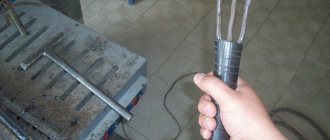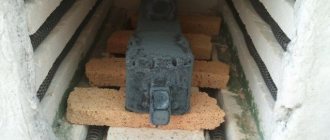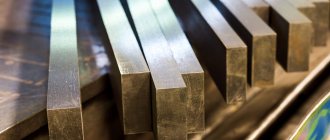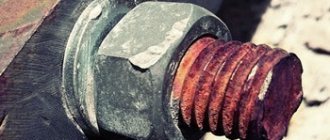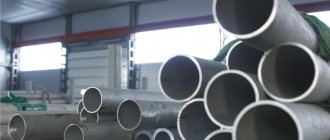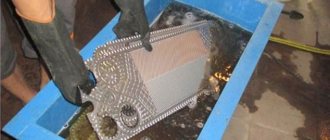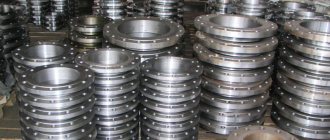What can be achieved by bluing
As a result of chemical or thermal treatment, a layer of iron oxide with a thickness of 1 to 10 microns appears on the surface of a steel part. The thickness of the layer is determined by the selected processing technology.
Blueing of metal allows you to achieve two main goals:
- Increasing the corrosion resistance of the product. Treated parts do not rust.
- Improved appearance. It is especially important for those parts that, due to operating conditions, cannot be painted.
Read also: DIY industrial hair dryer
Temperature conditions for bluing
The treatment does not affect other properties of the steel.
Blueing of steel is possible not only in production conditions, but also at home. There are many methods and compositions, almost all of them involve the use of chemically active substances that can cause serious harm to health. To successfully and safely use these substances at home, you must follow the following safety rules:
- Use a protective mask and gloves.
- Ensure ventilation of the room in which work is carried out.
- Use stainless steel utensils.
- Do not exceed the recommended processing temperature.
Methods for bluing metals at home and requirements for their implementation
Popular methods of bluing metal at home are:
- Boiling in self-prepared or purchased chemical compositions.
- Coating the steel with special oil and subsequent heat treatment.
- Coating the surface with the prepared composition at room temperature.
Burnishing steel at home
Chemical bluing of iron also involves preparatory operations of etching and cleaning, as well as grinding and polishing.
When carrying out blueing of steel, it is important to select a container for the solution so that it completely covers the object being treated.
Obtaining tarnish color
During oxidation, the heating temperature and its duration have a significant impact on the color of the surface. Tarnish colors can be obtained on any steel. The process of color appearance itself takes place very quickly, so it requires certain skills. Heating should be evenly spread over time. At factory enterprises, special ovens are used for this.
When working independently, you can use a stove, a blowtorch, or a gas stove, but only for small parts. It will be difficult to make a uniform color on a large surface of iron yourself at home; the color turns out spotty. The metal that has received the required color shade is removed from the heat with tongs and cooled with air oxygen. After drying, it is rubbed with oil; if the color quality is poor, the treatment is repeated.
Video on the topic:
Popular bluing methods
The most common methods of bluing at home are:
- alkaline;
- thermal;
- acidic.
The alkaline method is well suited for self-use at home. It will require
- water;
- precision scales;
- sodium nitrate and hydroxide.
For the coating to become durable, the process must last at least an hour and a half.
Alkaline
The technology for bluing steel using the alkaline method at home is divided into the following operations
- Degrease the surface with a solvent or special degreaser.
- Pour 100 g of water into a stainless steel container with a capacity of at least a liter.
- Add 120 g of caustic soda and 30 g of sodium nitrate, stir thoroughly until completely dissolved.
- Heat the solution to 130-145 °C.
- Place the product in the dish, avoiding touching the walls.
- After 20 minutes, after the part has turned black, rinse it in distilled water.
- After drying, generously lubricate the product with machine oil and wipe thoroughly.
Steel bluing with alkali
Careful adherence to proportions and parameters will allow you to obtain a smooth and abrasion-resistant coating that does not require polishing.
Important! The product must be completely covered with the solution throughout the treatment. Otherwise, coating inhomogeneities, color transitions, etc. are possible.
Acid
This method involves the use of acidic solutions.
Before starting processing, you should carefully remove all rust from the surface of the object. To do this, use ordinary sandpaper, and in hard-to-reach places and with severe rust, use a grinder or a screwdriver with a wire brush.
Means for degreasing steel before processing
Next, chemical cleaning is carried out. It is used for
- sodium triphosphate;
- ethanol mixed with kerosene;
- or pure kerosene.
The product is placed in a container with the solution so that it completely covers it and kept for at least a quarter of an hour. After cleaning, the product is washed with plenty of water and dried.
The composition for acid bluing consists of:
- water: 1 l;
- tannic acid: 2g;
- tartaric acid: 2g.
After thorough mixing and complete dissolution, the composition is heated to 150 ° C and the workpiece is completely immersed in it. Leave for 15 minutes, then rinse with running water and briefly dip in boiling water for complete and high-quality rinsing.
Components of the solution for bluing
The last stage of the process is soaking in machine oil for an hour. After drying, the product is ready for use.
Thermal
Thermal bluing is the oldest and simplest method for home use. The whole process boils down to heating the steel in the open air. It lasts until the upper layers of steel react with oxygen in the air and result in an oxide film. The more a part is heated, the darker it becomes.
It should be remembered that heat treatment also changes the physical properties of the steel of the entire product.
Read also: The best screwdriver under 5000 rubles
Secrets of bluing
There are many recipes for bluing. Each master prefers his own , some may have tricks. In ancient times, blued steel recipes were often kept secret. Today you can find various recipes for every taste.
Cold bluing
The following example of cold bluing of a house can be given:
- Take a liter of water (distilled), two types of acid: 30% hydrochloric (4 g), 69% nitric (13.5 g). Ferric chloride (170 g) and divalent copper sulfate (4 g) are also added.
- The mixture is treated with the surface and left for some time. The longer the better.
- Rust is removed using water steam and a brush.
- Everything is repeated until the result is the desired one. Some do this up to 10-20 times.
Recipe with oxidizing agent
For example, the following recipe for an alkaline solution can be given:
- You will need caustic soda (400 g), sodium nitrate (10 g), water (600 ml).
- The mixture should act for 30 minutes or longer.
- Then the surface is washed well, dried, and slightly oiled. If the alkali is not completely washed off, plaque will form.
Care should be taken during operation. Hot substances and chemicals can cause damage to health or damage property. It is important not to forget about the correct selection of containers, suitable clothing and basic safety precautions.
Features of chemical bluing and recipes for some compositions
Before applying a new coating at home, you must remove the old one. This is done by combining mechanical and chemical cleaning methods.
To obtain a durable and beautiful coating, the part must be boiled for 30 to 90 minutes, during which time part of the solution boils away. The workpiece must be completely covered with the composition at all times, so the composition must be prepared with a reserve and periodically topped up during boiling.
At the end of the chemical bluing procedure, the product should be washed in a soapy solution, dried and generously lubricated with oil.
There are many options for chemical bluing. In some, the composition is made by the master himself, while others involve the use of ready-made factory-made products, such as Parisian oxide, Voron3M, Clover and others.
Means for bluing metals
Relatively simple methods of bluing, available for doing it yourself, include surface application of oil, saltpeter and the purchased composition “Clover”
Sapphire for bluing
Oil coating
This is one of the most popular home methods. The technology is divided into the following operations:
- The part is sanded and degreased with a solvent.
- Cover with oil.
- In a muffle furnace it is heated to 350-400 °C. It is permissible to use an oven.
- The cooled part takes on a black or brown tint.
- To saturate the color, the procedure is repeated.
The oil is applied with a brush or by dipping the product into a container of oil. Different types of oil are used, such as
Use of saltpeter
Home craftsmen achieve excellent results using saltpeter solution. You can purchase a ready-made solution, or you can make it yourself:
- water-1000 ml;
- sodium nitrate - 0.5 kg;
- caustic soda - 0.5 kg.
After boiling for an hour, a smooth surface of a deep blue-black color is obtained that does not require further processing.
Means "Clover"
The gel-like product can be purchased in 50 ml jars and is used for alloys with a chromium content of no more than 3 percent
It is designed to restore localized corrosion. To obtain a bright shade, the product will have to be applied several times. The product should first be sanded and wiped with a degreaser.
Apply clover with a brush and leave for two minutes. The white-yellow coating that appears is washed off with water and the part is wiped with a rag.
Blackening of stainless steel
Burnishing or oxidation is a method of surface coating (finishing) of metal products in blue, black, blue-black or tarnished colors by exposing them to chemical and thermal methods.
It is used for the purpose of corrosion protection of metal products, and also gives the surface an attractive tint. There are many ways to surface tint metals. The main one is the creation of an oxide film.
The most common are chemical (alkaline and acidic) and thermal effects on the surface. As a result of this treatment, the chemical composition and structure of the surface layer changes. Externally, this is manifested by the formation of a film in the form of metal oxide.
You can carry out the coating yourself using simpler technologies.
Methods for bluing metals at home and requirements for their implementation
Common home methods for protecting and decorating metal surfaces include:
- boiling parts in special chemical compositions that you can prepare yourself;
- oil coating followed by heat treatment;
- applying the finished product to the surface using a brush.
Carrying out work during chemical bluing involves chemical etching and cleaning operations, as well as mechanical grinding and wiping of the surface.
In order to use bluing at home using chemical reagents, you need to create certain conditions:
- provide the work area with ventilation or exhaust;
- prepare a container from a neutral material that is not destroyed by chemicals. A vessel made of heat-resistant glass, earthenware or porcelain is best suited. If long-term boiling of the solution is required, you can use a stainless steel container;
- the container must have sufficient volume so that the part is completely covered with the composition;
- stock up on protective equipment: gloves, protective mask or goggles, aprons.
Features of chemical bluing and recipes for some compositions
Before performing work, the surface of the metal product is subjected to treatment: removing the old oxide layer by sanding and degreasing with a solvent.
The durable blued finish is primarily produced by boiling solution throughout the entire paint cycle. To obtain a durable film, the process should last from 30 minutes to an hour and a half, so the boiling solution is periodically topped up to ensure complete coverage of the part.
After the process is completed, the part is thoroughly washed using detergents and then lubricated with oil.
For household work, the alkaline oxidation method is mainly used. Let's consider some options for the chemical oxidation of metals in an alkaline environment.
Method number 1:
- Water is poured into a container (porcelain) of the appropriate size and sodium nitrate (sodium nitrate) and caustic soda (sodium hydroxide) are dissolved in it in the ratio: per 100 ml 30 g of sodium and 100 g of soda.
- The mixture is heated to 140 - 160 ° C, and the workpiece is placed in it, which remains there for at least 30 minutes.
If the process is carried out correctly, the result will be a deep black coating, sometimes with a bluish tint.
Method number 2:
A bluish tint to the film can be obtained using a boiling saturated alkaline solution in which potassium or sodium hydroxide is dissolved in high concentration. At least 700 grams of a chemical substance dissolves in 1 liter of water.
These recipes are provided as an example. There are many other chemical formulations using nitrites and nitrates.
Oxidation in an acidic environment is carried out at lower temperatures. For example, when using an acid solution consisting of:
- calcium nitrate – 30 hours,
- orthophosphoric acid – 1 hour,
- manganese dioxide – 1 tsp.
Oxidation is carried out by keeping the workpiece in the solution for at least 30-45 minutes at 100°C.
Means for bluing metals
Simple coating methods that can be used at home include technologies for surface application of oil, saltpeter and ready-made Clover.
These bluing products are easy to use and allow you to carry out work at home without special preparation.
Let's look at ways to create film using each of them.
Oil coating
The technology of creating a protective film using oil is the most common for home use.
It is done like this:
- the sanded and degreased product is coated with machine or sunflower oil;
- then it is placed in the oven and heated to 350 - 400 ° C;
- after cooling, the surface of the part becomes brown or black;
- Remaining oil from the part must be removed with a rag;
- To obtain a more saturated color, the process should be repeated several times.
You can use different oils, for example, gun, linseed or olive. It can be applied with a brush or by dipping the part into an oil composition.
:
If you need to blacken any part of the part, then it is better to use a blowtorch to do this. During this firing process, the color change in the surface of the workpiece is clearly visible. When a rich brown-black color is achieved, the heat treatment can be stopped.
Use of saltpeter
A good result of chemical bluing is obtained by a classic solution using saltpeter in addition to those given earlier. As a result of boiling the part in a solution of sodium nitrate at a temperature of 130 - 150 ° C, a durable oxide coating of a shiny black-blue hue is obtained.
Recipe for composition with saltpeter:
- Distilled water – 1 liter;
- Sodium nitrate (NaNO3) – 500 g;
- Caustic soda (NaOH) – 500 g.
Ready-made kits with saltpeter for oxidation are available for sale.
You can watch the process of bluing in saltpeter in the video:
The surface with this treatment looks smooth and does not require additional polishing.
Surface treatment with Clover
You can treat metal surfaces with the ready-made “Clover” product. It has a gel-like consistency and is sold in small 50 ml containers.
It is used for minor corrosion damage to metal. To obtain maximum coloring of the product, you need to treat it with Clover two to three times. Before applying it, the part must be sanded and degreased.
Cold bluing at home
“Clover” does not require heat treatment of the part, so this method is considered cold bluing. Cold bluing can be carried out by other means.
- "Voron-3M". The drug forms a dense film of deep black color on the surface.
- "Paris Oxide" An imported selenium-based preparation is supplied in three containers: 1- for surface preparation, 2- the main composition and 3- a fixative that gives the coating additional protection.
Liquid for cold bluing is applied to the parts with a brush, and after painting it is washed off with warm soapy water. The method is popular for processing barrels and other parts of firearms that do not require boiling.
Burnishing steel at home
If you are bluing steel at home, you need to wisely choose the components of the boiling solution. Heating hardened parts can lead to them losing their strength properties.
Alkaline solutions have a less harmful effect on steel, and experienced craftsmen advise choosing them. Treatment with acidic solutions is preferably carried out at low temperatures
So, for example, when using an acid composition for bluing steel from:
- calcium nitrate – 94%;
- orthophosphoric acid – 3%;
- manganese dioxide – 3%.
processing is carried out from half an hour to 45 minutes at 100 ° C
Metal blackening
Depending on the acidity of the environment in which the workpiece is processed, the color of the resulting coating changes, from yellow to black. Therefore, bluing and blackening of metal are not the same thing. The required shade is selected by varying the intensity and duration of heat treatment and the percentage of solution components.
If you take a mixture of 7 parts copper nitrate and 3 parts alcohol denatured alcohol, apply it to the product and heat it over a fire, then as it heats up the coating begins to change its color. When the desired shade is achieved, stop heating.
Read also: How to choose a drill for a hammer drill
It is also possible to blacken steel by coating it with oil and calcining it in an open flame. The result is a durable film of deep black color. There are other compositions for blackening.
Application of rust varnish
The method using the so-called “rusty varnish” is distinguished by its cost-effectiveness against the backdrop of quite acceptable quality of the coating.
The product is immersed in a chemically active corrosive liquid based on hydrochloric acid, which forms red and black oxides on its surface.
To remove rusty deposits, you will have to use a stiff wire brush. A black oxide film will remain on the product.
Ready rusty varnish
The method is long and labor intensive, but provides excellent results at home.
Before starting processing, as with all other methods, you should thoroughly clean the object with sandpaper and degrease it with a solvent.
The active liquid is prepared in special porcelain vessels; the use of protective gloves, an apron, acid-resistant shoes and thick work clothes is mandatory. A respirator and clear face shield should also be used.
A small amount of hydrochloric acid is poured into the vessel, adding rust scraped off the iron, sawdust and nitric acid. The mixture should be stirred carefully with a porcelain stirrer until bubbles stop appearing.
Next, carefully add water and vodka in equal parts. The solution is allowed to settle and drained from the sediment.
The result of using rusty varnish
The part is placed in the solution for a time sufficient to acquire a deep black color. At the end of the process, the part should be rinsed with plenty of water.
Attention! The solution used in this method is one of the strongest solvents. Beware of even the smallest splashes - they can cause very serious injury and property damage.
If splashes get on clothes, they should be removed immediately. If, despite all precautions, drops get on the skin, the affected area should be washed generously with a soda solution and immediately seek medical help.
Do-it-yourself metal blackening from steel
Oxidizing steel gives surfaces a beautiful appearance. You can protect the base from rust by rubbing it with a special mixture and subjecting it to strong heating. The preliminary procedure for cleaning the metal using the most effective solutions leads to an ideal, smooth, shiny surface.
Active mixtures:
- silver nitrate with water;
- antimony chloride with olive oil;
- ink-nut acid with ferric chloride and antimony;
- copper sulfate with iron filings and nitric acid with alcohol and water.
To quickly restore weapons and protect them from scratches, chips and other mechanical influences, oil is used. The crystalline, porous structure of the protective layer facilitates the penetration of fat, creating another additional layer of protection and shine. It is important to know that painted metal is darker when dried than when wet.
Using machine oil
Oil bluing of steel is also available at home.
To carry out the procedure you will need:
- 0.5 liters of oil.
- Equipment for placing the product: hooks, pliers, spacers.
- Stainless steel container.
- A sufficient amount of rags or non-woven napkins.
- Heat source.
Burnishing steel using machine oil
As a heat source I use a gas stove, a hair dryer or a compact gas burner.
The part is heated over an open fire or with a stream of hot air from a hair dryer, taken with pliers and carefully placed in a container with oil on pre-prepared wire hooks and stands so that it is completely immersed. This guarantees an even and expressive color. The oil treatment is repeated until the workpiece acquires the required shade.
This method provides good anti-corrosion properties at home, but, unfortunately, the coating is not very durable.
Cleaning the product from rust
This article described several of the most popular methods for bluing steel at home. They are used by hunters and collectors to restore the corrosion resistance and appearance of guns, by blacksmiths who forge handmade knives, and by car service technicians who bring old nuts and bolts back to new life. If you follow proportions and technology, your metal products will acquire an excellent appearance and a long life.
If you find an error, please select a piece of text and press Ctrl+Enter.
Author: 19alex78, September 9, 2010 in General
Painting of metal products
There are many different methods for obtaining protective coatings of different colors. The bluing procedure is carried out using chemical and mechanical methods. The resulting thin transparent layer does not change the structure of the metal. The mechanical method is carried out by applying paint or powder by spraying, hammering and enameling. The chemical method is more affordable and is often used for coloring at home.
The beginning of painting metal objects using a chemical method is to clean them from invisible contaminants and dust. After this procedure, the cleaned surfaces of the products are degreased. Small parts are immersed in prepared oil-dissolving solvents. It can be ether, gasoline, ethyl chloride. Large metal products are boiled in special baths with a dilute solution of sodium hydroxide. Cleaned items are placed in containers with paint without touching them with your hands.
